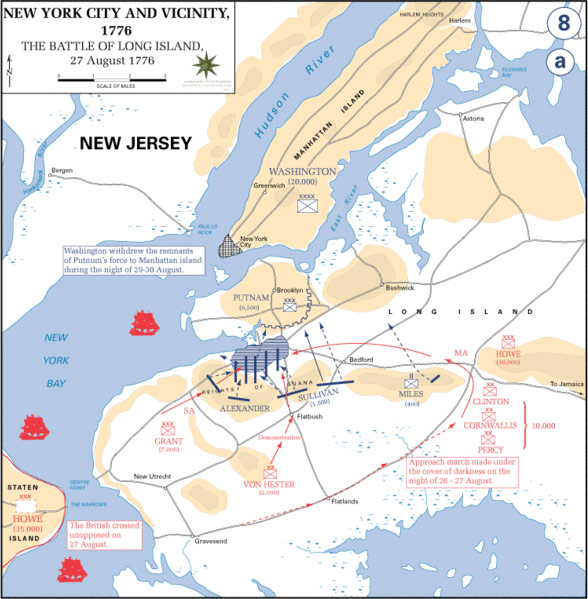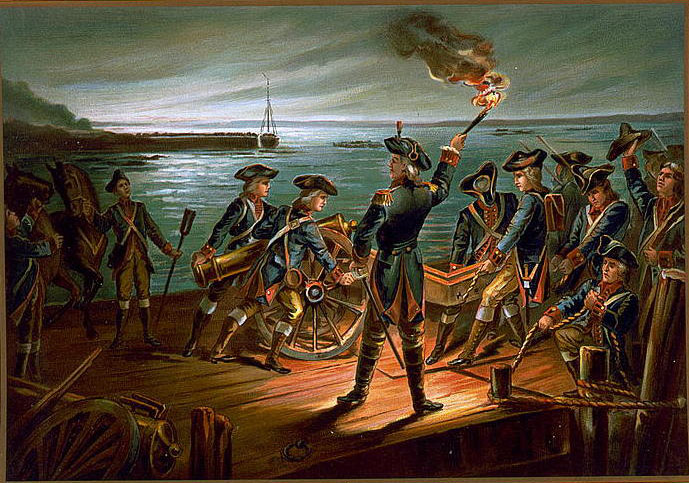 The Battle of Long Island was fought between British and American troops during the American Revolution. The battle began on August 27, 1776 and ended on August 29th.
The Battle of Long Island was fought between British and American troops during the American Revolution. The battle began on August 27, 1776 and ended on August 29th.
Armies and Commanders
In the Battle of Long Island, the British army was led by General William Howe with an army of nearly 20,000 soldiers. They were helped by naval forces under the command of Admiral Richard Howe, brother of General Howe. The Americans, with 10,000 soldiers, were led by General George Washington.
Buildup to the Battle of Long Island
George Washington started moving to the south of New York after successfully capturing Boston in March 1776 from the British. Washington correctly predicted that New York City would be the next target of the British. He made preparations to defend the city.
However, given the lack of naval forces, he was faced with an uphill task of defending the city surrounded by water. This would give the British the advantage. Despite persuasions to leave the city, Washington insisted on staying to defend the city since he believed that is played a major political role.
Washington’s Battle Plan
Washington began moving his troops to New York City on April, 1776. Washington decided to split his army into 5 divisions, 3 were deployed on the south-end of the Manhattan, 1 in Northern Manhattan, and 1 in Long Island. He started to move his troops to Long Island in early May.
Forts were built and cannons were installed to bolster the defense. Major General Nathanael Greene was to lead the troops who were in Long Island, but he became ill a few days before the battle. Israel Putnam took over the command. During the planning, Washington believed that the British attack on Long Island would only be a distraction, so he directed the main army to remain in Manhattan. Washington stayed back in Manhattan with a majority of the troops.
Howe’s Battle Plan
In June, under the command of General Howe, 32,000 troops arrived at Staten Island by sea. The British naval fleet had more than 400 ships by August that included 73 war ships. On August 22, 15,000 troops landed in Long Island. 5,000 additional troops that was to serve as reinforcements, arrived in Long Island. This brought the British forces total to 20,000.
The Battle of Long Island
 The American plan was to direct the defenses from Brooklyn Heights under the command of Putnam along with some of the men who were stationed at Guana Heights. The intent was to block the path to Brooklyn Heights. Washington’s plan was to inflict heavy damage on the British troops through the men stationed at Guana Heights, who would then fall back to main defenses at Brooklyn Heights.
The American plan was to direct the defenses from Brooklyn Heights under the command of Putnam along with some of the men who were stationed at Guana Heights. The intent was to block the path to Brooklyn Heights. Washington’s plan was to inflict heavy damage on the British troops through the men stationed at Guana Heights, who would then fall back to main defenses at Brooklyn Heights.
There were 4 passes through the Heights – Gowanus Road, Flatbush Road, Bedford Road, and Jamaica Pass. Out of these, Jamaica Pass was the least known and was located at the easternmost end of the Island. The Americans left it undefended. British General Clinton received information about the Jamaica Pass from those loyal to the monarchy. He proposed a plan to Howe to march the main army through the Jamaica Pass and flank the American army while the remaining troops kept the Americans busy by attacking from the front. Howe approved the plan and under Clinton’s command, 10,000 troops marched through the Jamaica Pass on the night of August 26.
On the morning of the 27th, Clinton’s army signaled the troops stationed at the front with a cannon fire, to begin the frontal attack. General William Alexander (a.k.a Lord Stirling) and General John Sullivan led the Americans at Guana Heights against the frontal attack from the British. Clinton’s army simultaneously flanked the American troops from the east.
Fierce combat took a heavy toll on both the British and Americans at the front line. The British successfully took over Sullivan’s position and gained the central path. Sullivan barely managed to evacuate the bulk of his troops to Brooklyn Heights before he was captured. Washington realized by this time that his assumption of the main attack on Manhattan was wrong; he ordered more troops from Manhattan to Brooklyn. It was too late, and the British had taken control of the battle.
 Stirling, who was defending the western front, managed to successfully thwart British attacks. However, after the British gained the main pass, they attacked Stirling from the left. British reinforcements were sent from the front. Stirling stayed back with 400 Maryland troops and ordered the rest to retreat to the Brooklyn Heights while those who remained bought by holding back the British and delayed their forward movement. In this suicidal mission to save the rest of the American troops, 256 of the Maryland soldiers were killed, ensuring the safety of the others.
Stirling, who was defending the western front, managed to successfully thwart British attacks. However, after the British gained the main pass, they attacked Stirling from the left. British reinforcements were sent from the front. Stirling stayed back with 400 Maryland troops and ordered the rest to retreat to the Brooklyn Heights while those who remained bought by holding back the British and delayed their forward movement. In this suicidal mission to save the rest of the American troops, 256 of the Maryland soldiers were killed, ensuring the safety of the others.
Retreat
Washington and his army prevented further damage and held onto Brooklyn Heights. The next day, British forces were slowed by digging trenches and did not force an all-out attack. Washington was advised to retreat to Manhattan and on August 29th, the American troops staged one of the greatest feats of evacuating more than 9000 soldiers in the cover of the night over water. Not a single life was lost during the maneuver. The British army was taken by surprise by this retreat and failed to cut down the American line of retreat.
The American army was defeated in Long Island, and Washington bore the loss of more than 300 troops killed, 700 wounded and nearly 1000 captured. Sullivan and Stirling were captured by the British. The casualties for the Brits were relatively less with 64 killed, 31 missing, and 293 wounded.
The defeat meant that the British captured New York City and the surrounding areas while Washington was forced to retreat to New Jersey and eventually to Pennsylvania. Many reckon that the American defeat at Long Island was attributed to splitting the army in two, between Manhattan and Long Island.